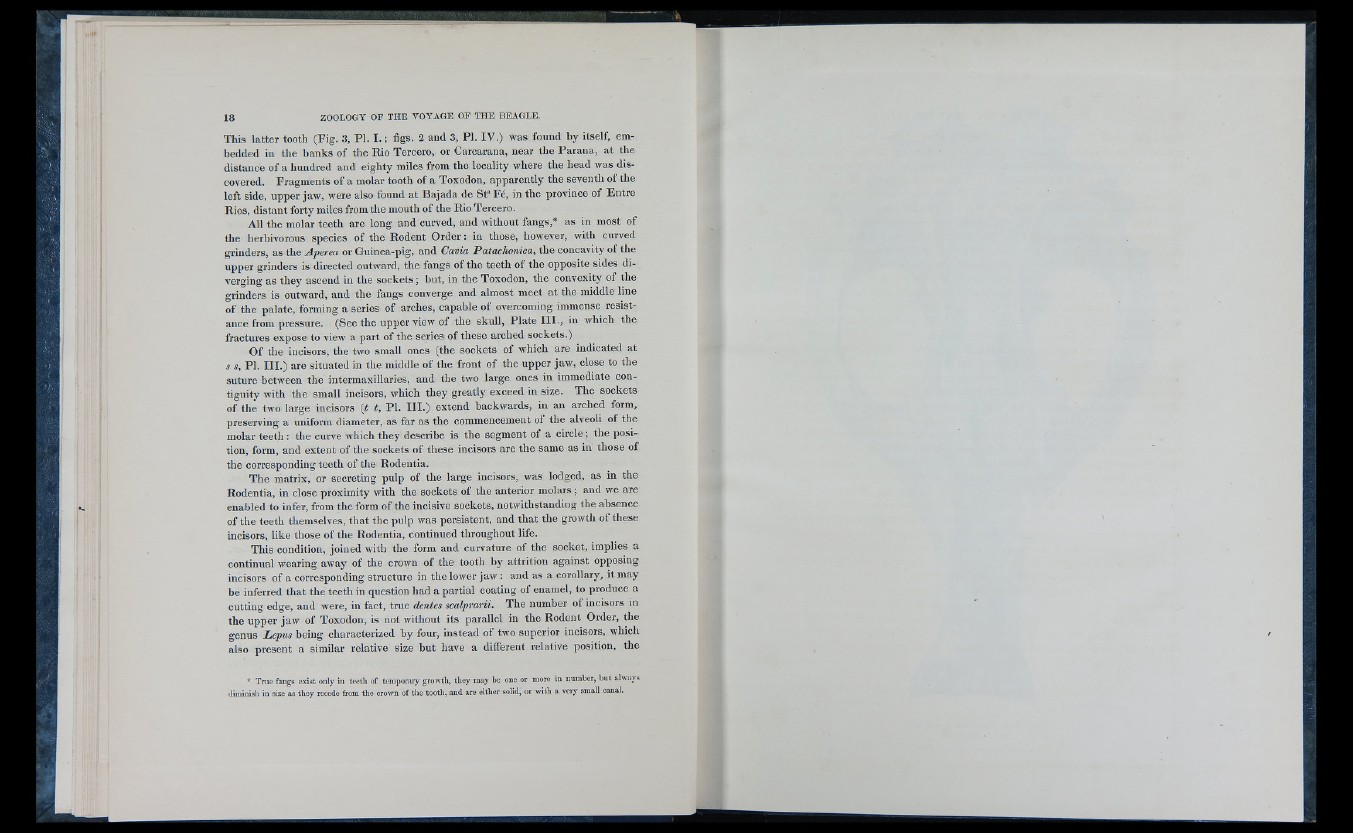
This latter tooth (F ig . 3, PL I . ; figs. 2 and 3, PL IV .) was found by itself, embedded
in the banks o f the Rio Tercero, or Carcarana, near the Parana, at the
distance o f a hundred and eighty miles from the locality where the head was discovered.
Fragments o f a molar tooth o f a Toxodon, apparently the seventh o f the
le ft side, upper jaw, were also found at Bajada de St"Fe, in the province o f Entre
Rios, distant forty miles from the mouth o f the Rio Tercero.
A ll the molar teeth are long and curved, and without fangs,* as in most of
the herbivorous species o f the Rodent O rde r : in those, however, with curved
grinders, as the Aperea or Guinea-pig, and Cavia Patachonica, the concavity o f the
upper grinders is directed outward, the fangs o f the teeth o f the opposite sides d iverging
as they ascend in the so ck e ts; but, in the Toxodon, the convexity o f the
grinders is outward, and the fangs converge and almost meet at the middle line
o f the palate, forming a series o f arches, capable o f overcoming immense resistance
from pressure. (S e e the upper view o f the skull, P la te I I I ., in which the
fractures expose to view a part o f the series o f these arched sockets.)
O f the incisors, the two small ones (the so ckets o f which are indicated at
5 s, PL I I I .) are situated in the middle o f the front o f the upper jaw, close to the
suture between the intermaxillaries, and the two large ones in immediate contiguity
with the small incisors, which they greatly ex c eed in size . The sockets
o f the two large incisors { t t, PL I I I .) extend backwards, in an arched form,
preseiwing a uniform diameter, as far as the commencement o f the alveoli o f the
molar te e th : the curve which they describe is the segment o f a circle; the p o sition,
form, and ex ten t o f the sockets o f these incisors are the same as in th o se of
the corresponding teeth o f the Rodentia.
The matrix, or secreting pulp o f the large incisors, was lodged, as in the
Rodentia, in close proximity with the sockets o f the anterior m o la r s; and we are
enabled to infer, from the form o f the incisive sockets, notwithstanding the absence
o f the teeth themselves, that the pulp was persistent, and that the growth o f these
incisors, like those o f the Rodentia, continued throughout life.
This condition, joined with the form and curvature o f the socket, implies a
continual wearing away of the crown o f the tooth by attrition against opposing
incisors o f a corresponding structure in the lower jaw : and as a corollary, it may
be inferred that the teeth in question had a partial coating of enamel, to produce a
cutting edge, and were, in fact, true denies scalprarii. Th e number o f incisors in
the upper jaw o f Toxodon, is not without its parallel in the Rodent Order, the
genus Lepus being characterized b y four, instead o f two superior incisors, which
also present a similar relative siz e but have a different relative position, the
* True fangs exist only in teeth of temporary growth, they may be one ot more in number, but always
diminish in size as they recede from the croivn of the tooth, and are either solid, or with a very small canal.